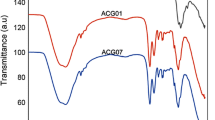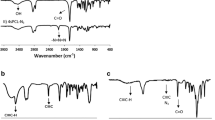Abstract
In this study, semi-IPN chitosan/poly(N-isopropylacrylamide) (PNIPAAm) hydrogels have been prepared via in situ UV-photo-crosslinking of N-isopropylacrylamide monomer using poly(ethylene glycol)-co-poly(ε-caprolactone) (PEG-co-PCL) macromer as a crosslinker in the presence of chitosan. Swelling properties of the resultant hydrogels were studied by investigating pH- and temperature dependence of equilibrium swelling ratio and oscillatory swelling–deswelling kinetics. It was found that semi-IPN hydrogels responded to both temperature and pH changes, and such stimuli-responsiveness was rapidly reversible. The rheological measurements demonstrated that the incorporation of chitosan greatly improved the mechanical strength of the hydrogels prepared. The release profiles of bovine serum albumin (BSA) from the hydrogels were also evaluated. The results showed that the release rate of BSA was higher in pH 2.0 buffer solution than in pH 7.4 buffer solution at 37 °C. Such double-sensitive hydrogels have the potential to use as smart carriers for drug delivery systems.









Similar content being viewed by others
References
Kim S, Lee CK, Lee YM, Kim IY, Kim SI (2003) Electrical/pH-sensitive swelling behavior of polyelectrolyte hydrogels prepared with hyaluronic acid-poly(vinyl alcohol) interpenetrating polymer networks. React Funct Polym 55:291–298
Kutty JK, Cho E, Lee JS, Vyavahare NR, Webb K (2007) The effect of hyaluronic acid incorporation on fibroblast spreading and proliferation within PEG-diacrylate based semi-interpenetrating networks. Biomaterials 28:4928–4938
Jeong B, Bae YH, Lee DS, Kim SW (1997) Biodegradable block copolymers as injectable drug-delivery systems. Nature 388:860–862
Kost J, Langer R (2001) Responsive polymeric delivery systems. Adv Drug Del Rev 46:125–148
Soppimath KS, Liu LH, Seow WY, Liu SQ, Powell R, Chan P, Yang YY (2007) Multifunctional core/shell nanoparticles self-assembled from pH-induced thermosensitive polymers for targeted intracellular anticancer drug delivery. Adv Funct Mater 17:355–362
Guilherme MR, Silva R, Girotto EM, Rubira AF, Muniz EC (2003) Hydrogels based on PAAm network with PNIPAAm included: hydrophilic–hydrophobic transition measured by the partition of Orange II and Methylene Blue in water. Polymer 44:4213–4219
Chen GH, Hoffman AS (1995) Temperature-induced phase transition behaviors of random vs. graft copolymers of N-isopropylacrylamide and acrylic acid. Macromol Rapid Commun 16:175–182
Shibayama M, Fujikawa Y, Nomura S (1996) Dynamic light scattering study of poly(N-isopropylacrylamide-co-acrylic acid) gels. Macromolecules 29:6535–6540
Kobayashia J, Kikuchib A, Sakaia K, Okano T (2002) Aqueous chromatography utilizing hydrophobicity-modified anionic temperature-responsive hydrogel for stationary phases. J Chromatogr A 958:109–119
Yoo MK, Sung YK, Lee YM, Cho CS (2000) Effect of polyelectrolyte on the lower critical solution temperature of poly(N-isopropyl acrylamide) in the poly(NIPAAm-co-acrylic acid) hydrogel. Polymer 41:5713–5719
Zhao SP, Ma D, Zhang LM (2006) New semi-interpenetrating network hydrogels: synthesis, characterization and properties. Macromol Biosci 6:445–451
Klouda L, Mikos AG (2008) Thermoresponsive hydrogels in biomedical applications. Eur J Pharm Biopharm 68:34–45
Chen J, Liu M, Jin S, Liu H (2008) Synthesis and characterization of κ-carrageenan/poly(N,N-diethylacrylamide) semi-interpenetrating polymer network hydrogels with rapid response to temperature. Polym Adv Technol 19:1656–1663
Muniz EC, Geuskens G (2001) Compressive elastic modulus of polyacrylamide hydrogels and semi-IPNs with poly(N-isopropylacrylamide). Macromolecules 34:4480–4484
Zhang JT, Cheng SX, Zhuo RX (2003) Poly(vinyl alcohol)/poly(N-isopropylacrylamide) semi-interpenetrating polymer network hydrogels with rapid response to temperature changes. Colloid Polym Sci 281:580–583
Zhang JT, Bhat R, Jandt KD (2009) Temperature-sensitive PVA/PNIPAAm semi-IPN hydrogels with enhanced responsive properties. Acta Biomater 5:488–497
Alvarez-Lorenzo C, Concheiro A, Dubovik AS, Grinberg NV, Burova TV, Grinberg VY (2005) Temperature-sensitive chitosan-poly(N-isopropylacrylamide) interpenetrated networks with enhanced loading capacity and controlled release properties. J Control Release 102:629–641
Qiu Y, Park K (2001) Environmental-sensitive hydrogels for drug delivery. Adv Drug Deliv Rev 53:321–339
Sawhney AS, Pathak CP, Hubbell JA (1993) Bioerodible hydrogels based on photopolymerized poly(ethylene glycol)-co-poly(alpha-hydroxy acid) diacrylate macromers. Macromolecules 26:581–587
Han DK, Hubbell JA (1997) Synthesis of polymer network scaffolds from l-lactide and poly(ethylene glycol) and their interaction with cells. Macromolecules 30:6077–6083
Zhao SP, Cao MJ, Li LY, Xu WL (2010) Synthesis and properties of biodegradable thermo- and pH-sensitive poly[(N-isopropylacrylamide)-co-(methacrylic acid)] hydrogels. Polym Degrad Stab 95:719–724
Wang XH, Du YM, Fan LH, Liu H, Hu Y (2005) Chitosan-metal complexes as antimicrobial agent: synthesis, characterization and structure-activity study. Polym Bull 55:105–113
VandeVord PJ, Matthew HW, De Silva SP, Mayton L, Wu BP, Wooley H (2002) Evaluation of the biocompatibility of a chitosan scaffold in mice. J Biomed Mater Res 59:585–590
Agnihotri SA, Mallikarjuna NN, Aminabhavi TM (2004) Recent advances on chitosan-based micro- and nanoparticles in drug delivery. J Control Release 100:5–28
Li X, Wu W, Liu W (2008) Synthesis and properties of thermo-responsive guar gum/poly(N-isopropylacrylamide) interpenetrating polymer network hydrogels. Carbohydr Polym 71:394–402
Felinto MCFC, Parra DF, Silva CC, Angerami J, Oliveira MJA, Lugao AB (2007) The swelling behavior of chitosan hydrogels membranes obtained by UV- and γ-radiation. Nucl Instrum Methods Phys Res B 265:418–424
Guo BL, Gao QY (2007) Preparation and properties of a pH/temperature-responsive carboxymethyl chitosan/poly(N-isopropylacrylamide) semi-IPN hydrogel for oral delivery of drugs. Carbohydr Res 342:2416–2422
Chambon F, Winter HH (1985) Stopping of crosslinking reaction in a PDMS polymer at the gel point. Polym Bull 13:499–503
Acknowledgments
This work was sponsored by Nature Science Foundation of Hubei Province (2007ABB033), SRF for ROCS, SEM, China, WUSE Research Fund (2008Z01) and National Basic Research Program of China (973 Program, 2009CB526402).
Author information
Authors and Affiliations
Corresponding author
Rights and permissions
About this article
Cite this article
Zhao, SP., Li, LY., Cao, MJ. et al. pH- and thermo-sensitive semi-IPN hydrogels composed of chitosan, N-isopropylacrylamide, and poly(ethylene glycol)-co-poly(ε-caprolactone) macromer for drug delivery. Polym. Bull. 66, 1075–1087 (2011). https://doi.org/10.1007/s00289-010-0390-y
Received:
Revised:
Accepted:
Published:
Issue Date:
DOI: https://doi.org/10.1007/s00289-010-0390-y




